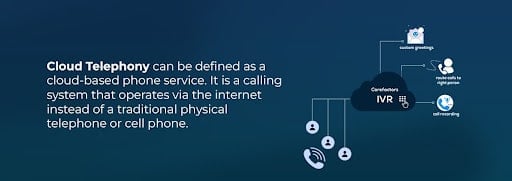Customers today expect businesses to be available across multiple channels at all times.
34% of global consumers rank having support available via their preferred channel as the single most essential aspect of service interaction and customer engagement.
For businesses to stay ahead in the game, meeting consumer expectations, resolving concerns, and acknowledging their comments via preferred means have now become non-negotiable. This is where cloud telephony will be of great help.
A persistent obstacle to maintaining high customer retention rates is a lack of quality communication. In the pursuit of achieving numbers, businesses often ignore the age-old saying that communication is key. This can become a daunting challenge as the organization grows and inter-departmental as well as business-customer engagement scales up.
Technological advancements and digital innovation have come to the rescue by giving brands the perfect opportunity to tick all the boxes of providing exceptional customer engagement.
Artificial Intelligence (AI) and Machine Learning (ML) have allowed the automation of tasks and the personalization of communication, freeing up employees to focus on what really matters in business: improving the customer experience and meeting customer needs.
The Importance of Communication in Boosting Customer Engagement
Place yourself in the shoes of the customer. Imagine a scenario where you have recently purchased a new software for your business automation needs and every team member has already made the shift to this new tool. The day-to-day working of your business is now dependent on the proper working of this software.
On a busy business day, this software is not functioning properly. The respective person from your team reaches out to customer support to get the issue resolved at the earliest. You have tried calling and have also sent an email. However, there has been no response for over a day now. The smooth functioning of your business is affected.
The concerned team does reach out to you with solutions after two days but the damage has already been done. Meanwhile, you made the decision to discontinue your subscription with this product and have already started your search for alternatives.
As a business providing service or product to others, you stand the risk of losing out on your customers due to delays in information delivery and customer support.
In the example given above, if the support team had reached out immediately with a temporary solution and let the customer know that it would take another two business days to resolve the issue on a more permanent basis, maybe they would not have lost you as a client.
Imagine having a system, where as soon as a ticket is raised by any customer, an agent is assigned and a call or email automatically goes out keeping the customer updated about every step of the support journey.
Customer Relationship Management for Customer Engagement
Unifying effective customer engagement platforms is key to succeeding in today’s rapidly evolving space. Integrating multiple tools into one saves time and also adds to technological advancements that improve and promote healthy competition among businesses.
An omnichannel contact center connects customers directly to one brand across voice note apps, calls, emails, chat sessions, messaging services, and social media. A few clicks allow salespeople to connect with their customers both via Email and via WhatsApp and SMS. No avenue is left unutilized. This increases the chances of visibility and customer retention.
Such a solution should include an expansive searchable database with customer and sales data, with deep integration between all tools ensuring teams can access this data instantly across every channel – no matter its source. To enhance the unified customer engagement platforms, you can use surveys across all channels for valuable insights and feedback.

What is a CRM Integration with In-built Cloud Telephony?
Interacting with customers, be it the first sales call or follow-up calls, booking appointments or sessions scheduled for customer support, is crucial for any business.
Alternating between a telephone system and a CRM to keep up with customers can be a bit too much at times. A CRM integration with in-built cloud telephony will solve this problem as agents can use the CRM itself to make calls.
But, what is cloud telephony?
Cloud Telephony can be defined as a cloud-based phone service. It is a calling system that operates via the Internet instead of a traditional physical telephone or cell phone.

The CRM can also record these calls for later analysis by the sales team to determine the lead quality and correct method of progressing along the sales pipeline.
A cloud-based solution redefines business convenience by offering a centralized hub for analyzing data, tracking performance, and making further improvements for customer engagement.
A cloud telephony solution would smoothen out any wrinkles in communication between business and customer by taking the menial task of manually dialing a number to connect with clients.
A CRM system with communication triggers in place also allows agents to automate outgoing calls within business hours, in case the first attempt at contacting the customer fails.
Benefits of Using a CRM Integration with Cloud Telephony
Using a CRM integration with in-built cloud telephony is like using a notebook that also comes with an attached pen. This integration ensures no more juggling between tools and accessing all required tools for customer service and engagement in one single platform.
CRM integration with cloud telephony is a holistic approach to customer-agent interaction, transforming it into a fluid and seamless experience. It comes with a treasure trove of real-time information and call metrics.
Using this data along with the data generated from other CRM-using teams, one can gain an overall view of the way the business operates and chalk out strategies for improvement, illustrated effectively through a Swimlane Diagram.
With markets favoring more precision and adaptability, cloud-based telephony and CRM integration is a key step toward business success. It helps do away with fragmented business operations and introduces a streamlined approach that enhances efficiency and assures better outcomes.
With the growth and diversification of a business, departmental silos arise. Each department might take up different tools, creating fragmented communication, disjointed customer interaction, and delayed responses and ticket resolution.
This inevitably creates a chasm between the business and its customers. The lack of unified communication can impact the overall customer engagement effort and satisfaction rates through hindered communication.
Implementing CRM integration with cloud telephony will help transcend departmental boundaries by fostering collaboration and coherence. Traditional call-handling methods no longer suffice when a business is in its growth phase and there is a large influx of customer calls.
Efficient routing of calls to correct agents becomes a challenge in the absence of cloud telephony. This can compromise service quality and result in unsatisfied customers.
Using a CRM integration with cloud telephony allows businesses to efficiently manage high call volumes, with prompt responses and minimized wait times.
Mentioned below are some of the advantages that this integration brings to the table.

-
Holistic Customer Overview
Unified customer engagement tools enable agents to see an overview of each customer before answering the phone.
This cloud telephony and CRM integration provides sales agents the tools necessary to provide a prospective customer with an experience that leads to increased sales conversion rates and greater satisfaction ratings.
-
Save Time with Click to Call
A CRM Integration with cloud telephony offers several additional benefits, such as the ability to instantly dial any prospect or customer from within the CRM and instantly create call notes in response to every customer call.
This removes the need for switching systems, decreasing errors while simultaneously increasing productivity. Furthermore, it facilitates quicker follow-up on leads while helping the sales team close more deals faster.
-
Always Stay Notified
This CRM integration also comes with an enabled pop-up screen whenever someone calls. The screen also shows the caller’s full details and customer status.
This feature goes a long way in businesses providing customers with exceptional service. By staying notified on the go, the support team can easily cater to customer inquiries and get them resolved as quickly as possible.
-
Enhanced Performance
The CRM integration with cloud telephony will ensure that teams give their best performance. This will result in increased team efforts for effective customer engagement and overall greater productivity.
Analyzing call recordings and providing feedback on them will lead to improved sales coaching and training initiatives. The call recordings can also be used for performance monitoring to identify bottlenecks and make changes that increase efficiency.
Conclusion
As customer engagement evolves into an ever more complicated process, companies must invest in technologies that enable them to provide highly individualized experiences for customers.
This may involve anticipating customers’ next steps with the business and offering product recommendations or proactive, personalized support driven by context.
This is something a unified customer engagement platform like Corefactors can accomplish effectively across every channel including mobile phone, chat, email, and social media.
Overcoming challenges in business communication channels and efficiently handling calls has transcended the tag of a mere strategic move. It is a necessity in the current business landscape.
By embracing innovative solutions like a CRM integrated with in-built cloud telephony solutions, businesses can not only bridge gaps that affect customer engagement, but can also propel themselves towards enhanced productivity and gaining a competitive advantage.











